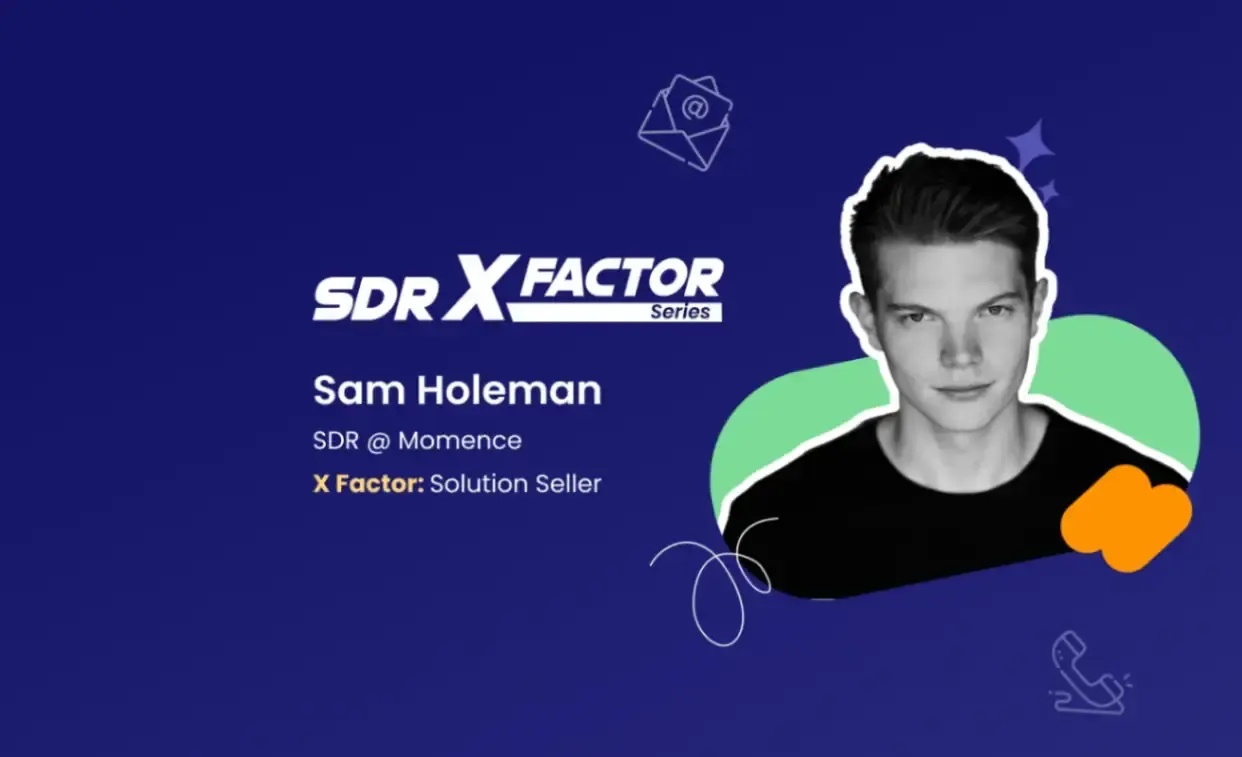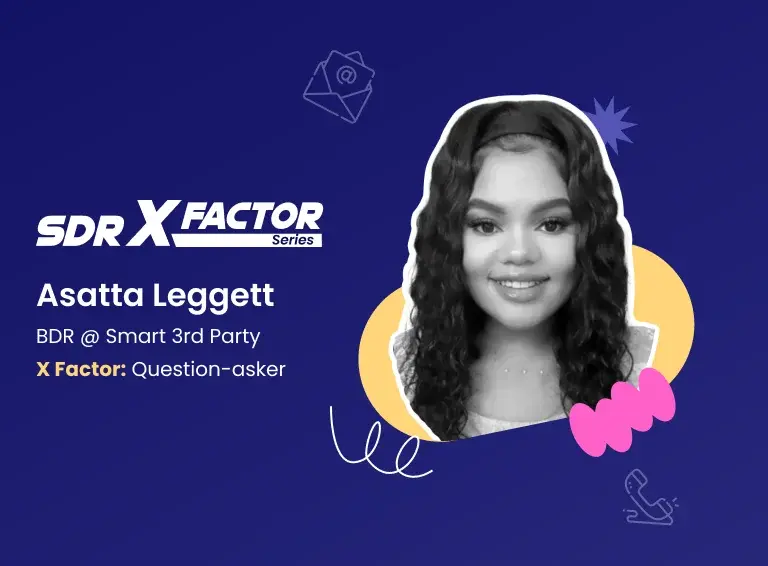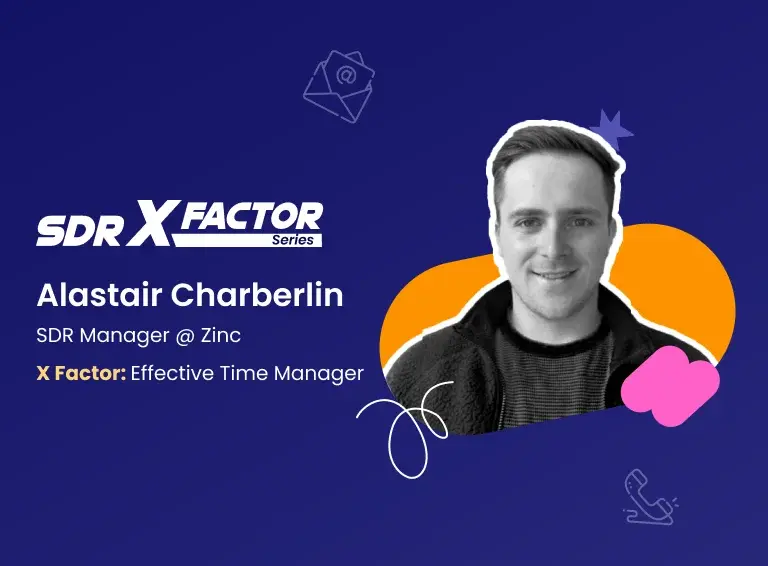The SDR X Factor is a series of long-form stories that aims to reveal what sets top-performing sales reps apart. How do they go about their day? What do their cold calling and cold emailing strategies look like? How are they crushing quota every time? We extract their key strategies, tips and tricks so you can sell better.
For the third part of this interview series, Sam Holeman, a Sales Development Representative (SDR) at Momence, joins us. Momence is a SaaS company that provides online platforms for businesses in the experience economy, like fitness studios, salons and spas.
Having worked earlier as a retail salesperson for Tesla, and now being an SDR in the SaaS space, Sam shares with us how he ended up in sales, his secrets for exceeding his meeting quota every month, and how he does cold calling and cold emailing.
1. From Tesla Car Salesman to Tech SDR

In two years of his professional career, Sam has accrued experience in both retail and SaaS software sales. Having graduated with a double major in Strategic Communications and English from University of Denver in the middle of the COVID-19 pandemic, he was anxious about landing a job, given the bleak job market.
He decided to take a chance, and walked into a Tesla showroom in Denver, Colorado shortly after his graduation. “I started talking to the manager. I was actually searching for a job, but I didn't ask to get hired there,” he recalls. As luck would have it, the manager told him about a job opening there, and whether he was interested.
Sam went on to spend a year at Tesla, where, as an automotive salesperson, he helped customers understand the cars, the purchasing process, and the delivery process. “A lot of it was account management. I wasn’t cutting deals,” he adds. A year later, as he moved to Los Angeles, California, he landed his current job as an SDR at Momence.
So, what difference does he find between retail and software sales?
"With retail and automotive sales, in a way, you're meeting demand. On the other hand, being an SDR involves creating demand. I'm calling someone with the idea of having a conversation about why they might be interested, or why it might be advantageous for them, to meet with us and learn more about what we're doing."
As a top-performing SDR, he’s been regularly hitting his quota of booking 12 demo meetings every month, and in November 2022, he managed to book 19 demo meetings, which was over 150% of his monthly quota.
Sam is also an actor, and has appeared in short films and TV series. He says that as an SDR, he enjoys connecting with people, understanding how they think, and influencing their minds. “Being a salesman takes grit and wit,” he asserts. “You’ve got to be smart, and you also have to be persistent. And you have to be passionate.”
i) What Sets Him Apart?
a) Emotionally Invests in the Prospect’s Business While Interacting
“When I first get on the phone, I am investing in their business,” he says. Instead of sounding like a telemarketer reading off of a script, he delivers his opener with confidence and assertiveness that not only shows that he has researched them well, but also explains the benefits that the prospect will get from his product.
After introducing himself to the prospect, he continues: “Most people who are using our platform, they're looking for something to save them time, save the money, increase the return on investment and give them more features to control their client journey. Would you be interested in learning more about any of these things at a later time?”
b) Cultivates a Mindset To Sell a Solution, Not Just a Product
Solution selling involves presenting your product as a solution to the specific pain points of the prospect, as opposed to a generalized, one-size-fits-all product selling. An advocate of solution selling, Sam notes that no good business wants to just take the customer’s money, but to provide them with a service. “A big part of my job is cutting through obstacles and barriers and getting people to understand what we're really trying to do,” he describes his selling process.
c) Uses Spontaneity to Tackle Unpredictable Situations
“Every day is different. And that's what's fun about the sales and being an SDR,” he says. With every day being a brand new day in sales, Sam resorts to spontaneity to tackle this unpredictability. For cold calling, he doesn’t have any script that he sticks to, because each prospect is different. Some could be defensive and others could be blunt. “You have to match energy with people,” he explains.
2. How Sam Pulls off Making 100 Cold Calls a Day
When it comes to outreach, Sam prefers cold calling over emailing, as he found from experience that calling works better with his target market of fitness studio owners.
Calling will also generally be the first step in outreaching, as he might not have the correct information on the prospect in his CRM. “Depending on how those calls go and where it goes, then I might put them into different sequences depending on what kind of call it was, if I got an answer or not, a gatekeeper, and if it's qualified,” he says.
Also, Sam manages to make at least 100 cold calls in a day—a number most SDRs wish they could pull off. On a regular day, it takes him around 5 to 6 hours to make 100 calls.
From research to booking a meeting, how does Sam’s cold calling process pan out? Let’s take a look:

i) Spends Minimal Time on Research; Gets Only the Essential Details
Given that he’s making 100 calls a day, one way that Sam cuts down on time is to not spend too much time researching the prospect. Having checked the list of prospects in his CRM, he dials the prospect’s number and pulls up only 2 pieces of information:
- What software they're currently using
- Who’s the decision maker
“As I'm going through my tasks, I hit ‘call’, and I just go to their website. I've become fast enough that I can get all the information I need by the time they pick it up,” he notes.
If there’s not a lot of information on the prospect in the CRM, he then spends a few minutes researching them before dialing the number.
ii) Approaches the Prospect Like a Consultant Pitching an Idea for Their Business:
To get the prospect interested during the call, Sam approaches the call not like a typical salesperson, but like a consultant who’s pitching an idea for their business. He gives an example of an opener with this consulting approach: “Hey, I've got this great idea. I work at a company called Momence. I was doing some research on the company. I think you'd be really interested in us and what we do here.”
This usually lowers the prospect’s defenses and gets them to open up a lot better. “When you're honest with them, they get honest with you. And then once they get honest with you, then you know how to respond to their obstacles and their concerns,” he elaborates.
iii) Delivers Openers With Full Confidence
“People will stay on the phone with someone who's very confident,” he asserts. Delivering the opener with the optimum level of confidence is essential as only then would prospects keep talking to you, according to him.
Here are some examples of openers that Sam uses:
- “I was looking around your website, I think you might be interested in this feature that we have. When would you be available to talk more about this?”
- “Hey, you're using one of our competitors. I'm curious what you think about this.”
- “We're a studio suite platform. We've worked with a lot of people who have used {competitor} in the past and just haven't been happy with their software or looking for something more modernized. I had this idea for you. Are you using automation right now?”
Being spontaneous, he does change his openers around for each prospect. However, the underlying method stays the same: he introduces himself, his business, and dives directly into the prospect’s pain point and the solution.
iv) How Sam Handles Different Kinds of Objections
a) Objection: “We Already Have a Solution in Place.”
This is the objection that Sam hears the most from the prospects, where they resist transitioning to a new solution because of their existing systems. Here, Sam adopts a strategy that he calls “reframing the conversation.” Once the prospect gives him this objection, he takes the conversation back to the pain points and the solution they’re seeking.
“If someone says, ‘I don't want to transition,’ I tell them, ‘That's not our goal. Our goal isn't to make your transition. Nor is that my job, actually. My job is to reach out to you, and talk about your business and see if we can maybe provide a solution for you, make your life a little easier. Our other goal is, we want to show you the platform and show you why people are using our platform, and then transition is up to you’,” he explains.
b) Objection: “We’re Comfortable With Our Existing Platform.”
This is another example of how he reframes the conversation. If a prospect tells him that they can’t transition to a new platform because they’ve spent a lot of time learning how the existing platform works and they’ve now grown comfortable using it, he replies: “Have you ever thought about the fact that you've spent so much time investing in the software that's probably inherently broken? That's why it's taken you so much time? Have you ever thought that maybe there could be something out there where you don't need to spend them on?”
c) Objection: “I’m too busy right now.”
When Sam encounters this objection, where he senses that the prospect is not interested and is trying to brush him off, he’ll reply with: “Look, I don't want to take your time. It's going to take 30 seconds.” And then, he gives them a brief value proposition of his platform.
However, when the prospect tells him that they have an urgent appointment, he would call them later at their convenience.
d) Objection: “I’m Not the Right Person.”
Upon hearing this, Sam simply asks for the contact details of the right person. While it hasn’t always been easy to get the contact details, he notes that sounding honest and excited during the interaction helps in getting them to open up.
An example he gives for this situation is: “Hey, I just want to chat up. I've got this great idea. But then, how can I get hold of {person's name}?”
v) Talks to Gatekeepers Like He Knows the Decision Maker
When SDR find themselves in the tricky position of encountering gatekeepers, exuding confidence in your voice is crucial to get them to connect you with the decision maker, Sam suggests. How confident? Like you’ve already booked the meeting with the decision maker.
“When I talk to gatekeepers, I talk like I know the owner. That’s the tone I have. I'm talking like I already have a meeting with this person,” he explains. This usually gets the gatekeeper to connect him to the decision maker. “Gatekeepers are very helpful, actually. But, if you sound like a telemarketer, gatekeepers are trained to block you,” he adds.
Sounding confident might also help in getting the gatekeepers to open up and share some crucial information—like whether the decision maker likes the product they’re currently using—that you’re seeking. So, Sam never talks down to the gatekeepers. “Don't take them for granted. Don't just push them over. They’re people too,” he stresses.
vi) Practices Empathy To Build Rapport
According to Sam, the best way to build rapport with prospects is to actively practice empathy in a sales context, which he terms as “challenging empathy.” He defines it as “really knowing your target market and understanding what it's like being the person you're talking to.”
As his prospects are fitness studio owners, he learns how their studio functions along with the prospect’s pain points and goals. With this knowledge, he goes on to ask them highly specific questions during the call. “That naturally builds rapport because then they go, ‘Well, this person knows what they're talking about. They're not just trying to get me on a call and make money off of me,” he explains.
vii) Sam’s Tips From His Successful Cold Calling Journey:
a) Always Ask Thought-Provoking Questions
When you’re on the phone with your prospect, Sam recommends asking them thought-provoking and open-ended questions that are backed by your research to keep the conversation going. Some of the questions he asks during the call are: “Are you seeing a return on investment with your current software?” “Are you a mobile-first type of business?” and “Do you feel like the software is working for you or do you feel like you're working for the software?”
b) Don’t Use Your Customer Service Voice
This is a tip he heard from one of his colleagues. No offense to the customer service people, but it just means to avoid sounding fake and inauthentic that might put prospects off during a call. “Just talk to people like you're human; don't talk to people like a robot,” he adds.
3. Why Sam Prefers a No-Frills Approach for Cold Emails

Although Sam sends about 70 cold emails a day (both automated and one-off emails), his outreach is less email-heavy and more call-heavy as he found that he gets to book more meetings with his target market through calls. “Most people are not going to book a demo through an email,” he says.
So, he prefers to stick to a basic, no-frills approach to crafting his cold emails. The built-in email sequences in his CRM would be simple. “They present simple information and links to more videos, and very introductory information. You don't want to overwhelm these people and send them too much information,” he notes.
How does Sam make his approach to cold emailing work? Let’s take a look at some highlights of Sam’s cold emailing process:
i) Asks a Question in the Subject Line To Pique Prospect’s Curiosity
The usual template that Sam uses for his introductory cold email is he asks a question in his subject line, and answers the question in the email body.
For instance, the subject line would be “What is Momence? Here's some basic information for {first name}.”
“This is like a basic lesson from college: You can start an essay by asking a question that makes you go up, that makes everybody pay attention,” he says, adding that opening with a question is also what many public speakers do.
ii) Prefers Longer Subject Lines Over Shorter Ones
Sam is a fan of long subject lines, given his word limit is less than 10 words. The subject lines tend to be longer because of his approach of asking questions.
Some of the subject lines in this format include:
- “What is Momence? Here's some basic information” (first email)
- “Following up: When are you available?” (follow-up email)
- “What is our next step, {First Name}?” (breakup email)
iii) Uses Emojis Relevant to His Company’s Marketing Initiative
Sam uses emojis to draw connections between his company's marketing initiative and his outreach. So if the marketing department has mailed a bottle of wine and a pineapple to each prospect as part of a physical warming up campaign, he'll add a couple of wine and fruit emojis in his cold email to those prospects to give them instant recall.
The combined efforts from the marketing team and Sam to get the prospect's attention works great. "It's a tee up for the salesman, and it works great. Actually, people really appreciate it," he notes.
iv) Keeps His Email Personalization Basic and Avoids Over-Personalization
Sam does not spend a lot of time personalizing his emails. His email sequences would include placeholders for the prospect’s name and their company name, and that’ll be it. “When you're doing bulk, you can't over-personalize. It doesn't work in my perception,” he explains.
During his cold calling, if he encounters a gatekeeper who expresses interest in his platform and shares any contact information, he would send a one-off email and personalize it with the details from the call. An example would be: “I spoke to Pam. They told me Mike was having trouble with this software. By the way, we work with a company that's actually down the street from you. Here's a link to check them out.”
v) Sends 4 Short Emails per Prospect
For cold emailing, Sam usually sends 4 emails per prospect, including the breakup email. The first email would contain links for videos on his platform, and the next 2 follow-up emails would have an embedded image that’d redirect the prospect to a video if they click on it.
The breakup email won’t have any visual elements. An example of a breakup email he sent to a prospect is: “Hey, {first name}, I was just hoping to get an update. I'd love to hear your thoughts over a quick call, unless we're letting this go. Just let me know.”
He stresses that the first 3 emails will be brief, with 3 to 4 sentences that follow the format of “This is what we do, this is why we're doing it, what time do you have to meet?”
“People don’t want to read a long email,” he notes.
4. Tête-à-Tête With Sam

i) One Thing That You Will Not Compromise on When It Comes to Work-Life Balance?
“I don't like working on work when I'm done with work.”
ii) Do You Have Any Favorite Sales Books/Podcasts?
“No. Once I'm done for the day, I'm reading the book I want to read. I’m going to the gym, I'm going to the movies.”
iii) What Would You Do if a Prospect Contacts You After Your Work Hours or During the Weekend?
“If someone pings me on the weekend, it takes me 2 seconds to get on my email on a Saturday and maybe send them an email. Those kinds of maintenance communication, I don't mind doing that on the weekends.”
iv) What Would You Do To Unwind Yourself After Work?
“I work out in the mornings. After work, I like to read a lot. I also do a lot of acting stuff.”
v) Best Sales Advice You’ve Ever Received?
“We're not selling a product. We’re selling solutions.”
Interviewed and written by: Akileish R





